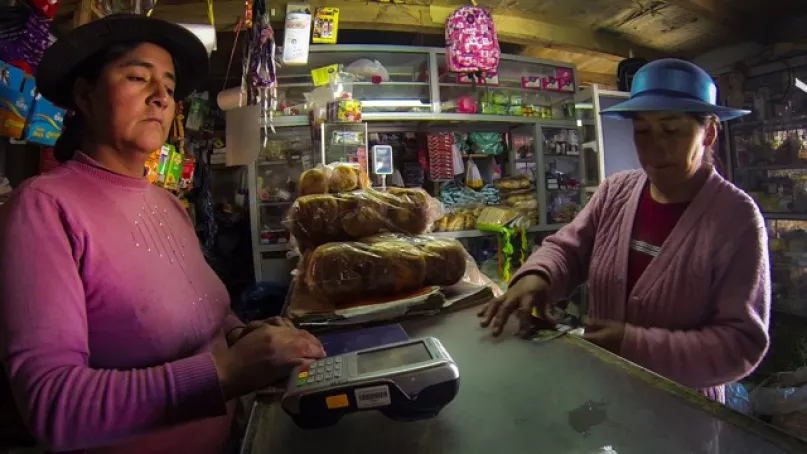On the Way to Reducing the Gender Gap in Latin America

Women's financial inclusion is a promising strategy for development and reducing inequalities. It can contribute to several of the United Nations Sustainable Development Goals, the financial stability of women's families and the economic growth of their countries. Financial inclusion can also help women to improve their negotiating skills and consequently, their investment in productive assets and the education of all children in the household. The benefits are significant, and the potential is transformative.
Achieving these benefits, however, requires much more than simply opening accounts in women’s names. The nature of women’s financial exclusion is complex and layered, overlapping with multiple structural limitations that women face, including lower literacy levels, difficulty gaining access to identity documents and greater economic dependence on the family and the informal economy. As such, reaching a level of financial inclusion that addresses these limitations and achieves substantive change will also be complex, depending on factors such as the complementarity of services, access to diverse opportunities, and the flexibility of gendered social norms.
Introducing National Financial Inclusion Strategies
To address these layered challenges, many countries in Latin America are implementing initiatives that are national in scope. To date, 13 countries (Brazil, Mexico, Paraguay, Peru, Chile, Colombia, Ecuador, Guatemala, El Salvador, Haiti, Panama, Trinidad & Tobago, and Honduras) have made public, intersectoral commitments, consolidated in what are known as National Financial Inclusion Strategies (NFIS). Their popularity is based on the potential for multi-sectoral coordination, which is especially needed for reaching the most vulnerable sectors.
Results worldwide have been generally positive. NFIS have helped countries conduct exhaustive assessments and establish political and operational commitments at the highest levels of government. They have led to the attainment of milestones and trends that would be difficult to reverse, including the widespread use of accounts among traditionally excluded sectors.
Initial positive results
In the region, the number of poor people with at least one account increased rapidly between 2011 and 2014, resulting in a reduction of inequality in access by income level. The percentage of women with an account increased by nearly 40 percent between 2011 and 2014; at the same time, the gap between men and women decreased, from 9 to 6 percentage points of difference, with a greater reduction in countries that had more significant gaps.
This trend correlates with the linking of government payments to financial accounts, typically in the name of the mother in each family. In 2014, 39 percent of people who received government transfers did so through their first account in the financial system; 68 percent of them were women. Consequently, the gap in the lowest-income segments proved to be nearly non-existent in 2014 and men and women showed equal access to regulated and protected products and services.

But then the gender gap went back up
Although NFIS have been effective for closing gaps in countries that began with high levels of inequality, they have also proven to be insufficient for definitively overcoming differences between men and women. Some countries that initially saw their gender gap shrink between 2011 and 2014 reported an increase in the gap again by 2017, and the great majority of users in these countries continue to withdraw all of their money once they receive notification of payment. Among the many reasons that women give for not using their accounts is the perception that these products do not match their characteristics and needs (According to Findex 2014).
So how can we improve National Financial Inclusion Strategies?
In evaluating the contributions of NFIS to reducing gender gaps, progress so far has been mixed. Making national commitments is a first step in putting women's financial inclusion on the agenda. However, only five of 11 NFIS in Latin America mention women in their assessments (Haiti, Jamaica, Mexico, Paraguay and Peru), and only two consider them as a special interest group (Haiti and Peru). No strategy proposes reduction of the gender gap as an indicator of success. Given that women are invisible throughout the operating plans, it should not come as a surprise when inequality in access to and use of financial services eventually goes back up.
Lack of sex-disaggregated indicators is another concern. NFIS have proven to be powerful tools for generating information and conducting national and regional assessments, as they create mechanisms for monitoring progress in access to and use of financial services. However, without sex-disaggregated data, there is a risk of concealing possible inequalities that could accompany progress in financial inclusion.
Finally, the NFIS in Latin America succeed in aligning a series of national interests through new management structures, often led by the country's Ministry of Economy and Finance. Many, however, lack institutional mechanisms for monitoring tasks and allocating budget funds that make such follow-up possible. Without a clear and detailed work plan, NFIS run the risk of becoming instruments that focus on short-range goals, which will be of only partial benefit to women.
In short, important agreements and commitments have been reached, and the region is clearly headed in the right direction. There is, however, a significant lack of attention to the development of the gender-sensitive initiatives necessary for achieving a real and sustained reduction in inequalities.
The next versions of the National Financial Inclusion Strategies need to make explicit their commitment to closing gender gaps and develop the mechanisms necessary for implementation, monitoring and measurement. Without these measures, we will find ourselves stalled in the middle of the road towards gender equality.


